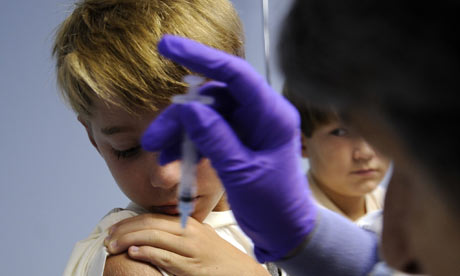
As the government prepares to roll out the swine flu vaccine campaign, few people are aware of a US vaccination programme more than 30 years ago that was abruptly stopped after reports of deaths and adverse reactions.
In early February 1976, an 18-year-old soldier at Fort Dix, New Jersey, collapsed and died suddenly. Subsequent tests revealed that four men at the base, including the dead soldier, were suffering from a strain of swine flu. In total, 13 soldiers developed the disease.
The possibility of a pandemic on the scale of the one in 1918, in which one million Americans had died, was soon being discussed in the press. Although many scientists expressed reservations, some officials at the Center for Disease Control (CDC) argued for a mass vaccination programme. Such an unprecedented undertaking required months of preparation, so President Gerald Ford's government was under pressure to act quickly, particularly as 1976 was an election year. In March, Ford announced that he was asking for $135m (£82.6m) for a vaccination programme. Congress agreed immediately.
The National Swine Flu Immunization Program Act was passed on 12 August, and it made the US government liable for any damages, after the insurance industry refused to indemnify the vaccine manufacturers.
The vaccination programme started on 1 October with the televised vaccination of the president and his family, but within days, the deaths had been reported of two elderly people. Weeks later, a Minnesota doctor reported that a patient had developed the neurological condition Guillain-Barré syndrome (GBS) after vaccination. Other similar cases followed in Minnesota, with one death. By December, the CDC announced that 30 people had developed GBS within a month of being vaccinated. The possibility of a link meant that the vaccination programme was immediately stopped.
A subsequent CDC investigation found that vaccination increased the risk of developing GBS eightfold, and it was decided to compensate anyone who developed the syndrome within 10 weeks of vaccination. In all, 4,181 people successfully claimed damages, costing the American taxpayer nearly $93m (£57m). However, many argued that the supposed link between GBS and the vaccination was the result of reporting bias. For example, 80% of the US armed forces were vaccinated, twice, yet no increase of GBS was found in military personnel. In the Netherlands, the only other country that vaccinated against swine flu, studies revealed that there was no increase in the incidence of GBS, despite over 1.5m vaccinations.
The context of the current UK swine flu vaccination programme is different from the US inasmuch as 1976 was an anticipated epidemic that never materialised; no other cases were found anywhere in the world. Liability is also not an issue. Britain has a government compensation scheme for damage caused by routine childhood vaccinations, and this will apply to swine flu.
Yet, so far, the majority of swine flu cases continue to be mild, and there are no signs of the virus mutating. Given that the first people to be vaccinated will be those with underlying health conditions, such as diabetes, asthma and heart disease, it is a statistical certainty that there will be some deaths among these people soon after vaccination. Whether or not these are caused by the vaccination, some will argue that the vaccine is unsafe. Indeed, anti-vaccination websites are already recounting the alleged link between the 1976 vaccine and GBS as "proof" of the potential dangers of swine flu vaccination. And a survey published this month by the Lancet revealed that about half of pregnant women will refuse the vaccination.
One positive message from 1976 is that it is possible to vaccinate large numbers of people, and that vaccination may save many lives. But safety concerns could derail any vaccination programme and dent confidence in vaccines and healthcare professionals. For the forthcoming vaccination campaign to be successful, lessons need to be learned from 1976. Healthcare professionals should be alert to any possible coincidental or vaccination-related adverse events. In the UK, this data is collected by the Medicines and Healthcare Products Regulatory Agency, which has set up the "swine influenza portal" for reporting adverse reactions to the antiviral drugs Tamiflu and Relenza, and it will be extended to include the vaccination. This system is also open to members of the public to report any adverse reaction to the vaccine they think they have had.
Most importantly, there needs to be effective and balanced communication. The responsibility for this rests with politicians, the media and the Department of Health, as well as individual healthcare professionals.
The government needs to heed criticisms of its failure to come clean about potential problems with Tamiflu. Without a balanced acknowledgment of the risks and benefits of vaccination against swine flu, the scene is set for a repeat of the MMR scandal, which has led to a resurgence of measles after a claim in 1998 that the vaccine was linked to autism resulted in many parents not getting their children vaccinated.
• Peter Washer's book, Emerging Infectious Diseases and Society, will be published by Palgrave Macmillan next year

